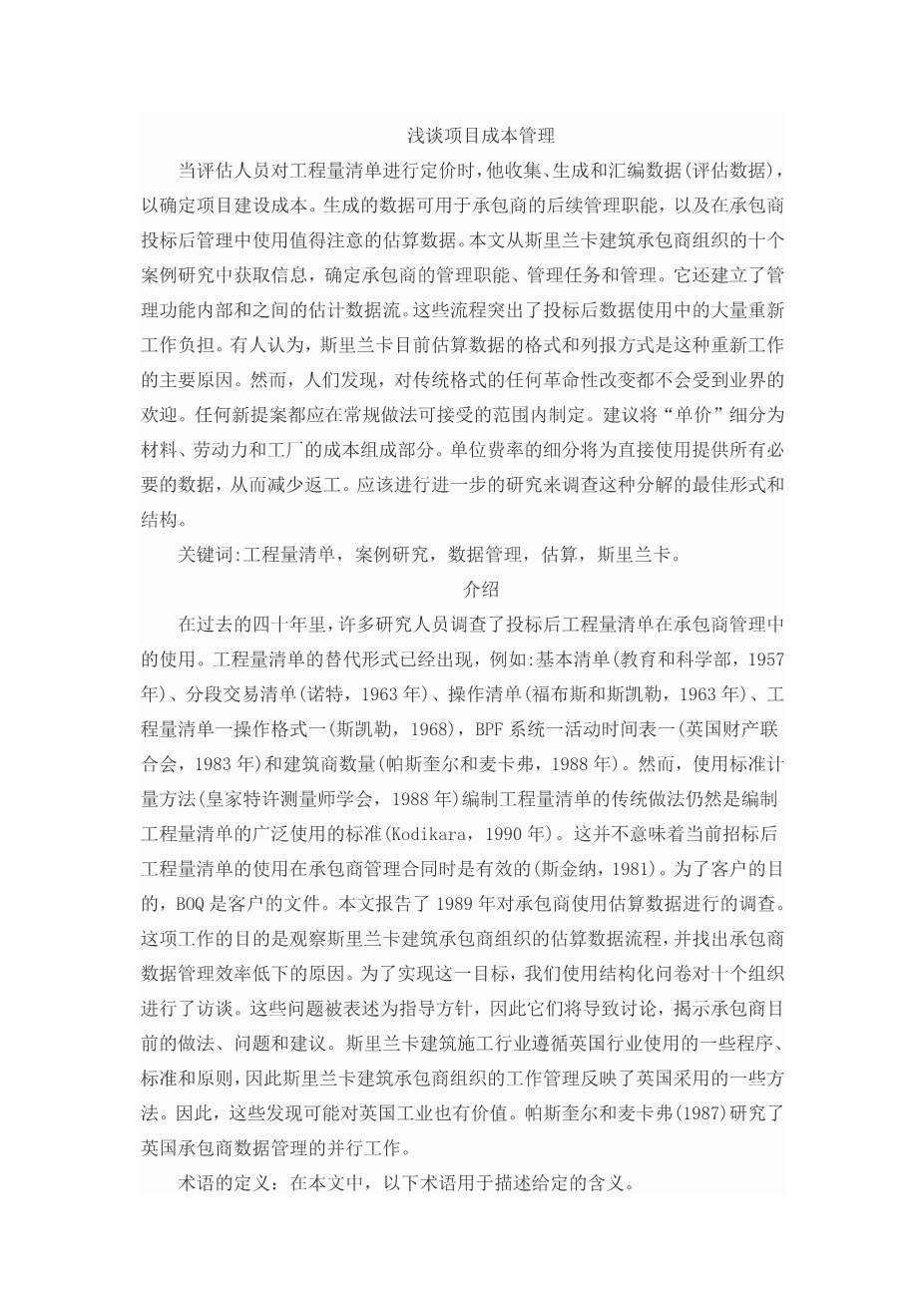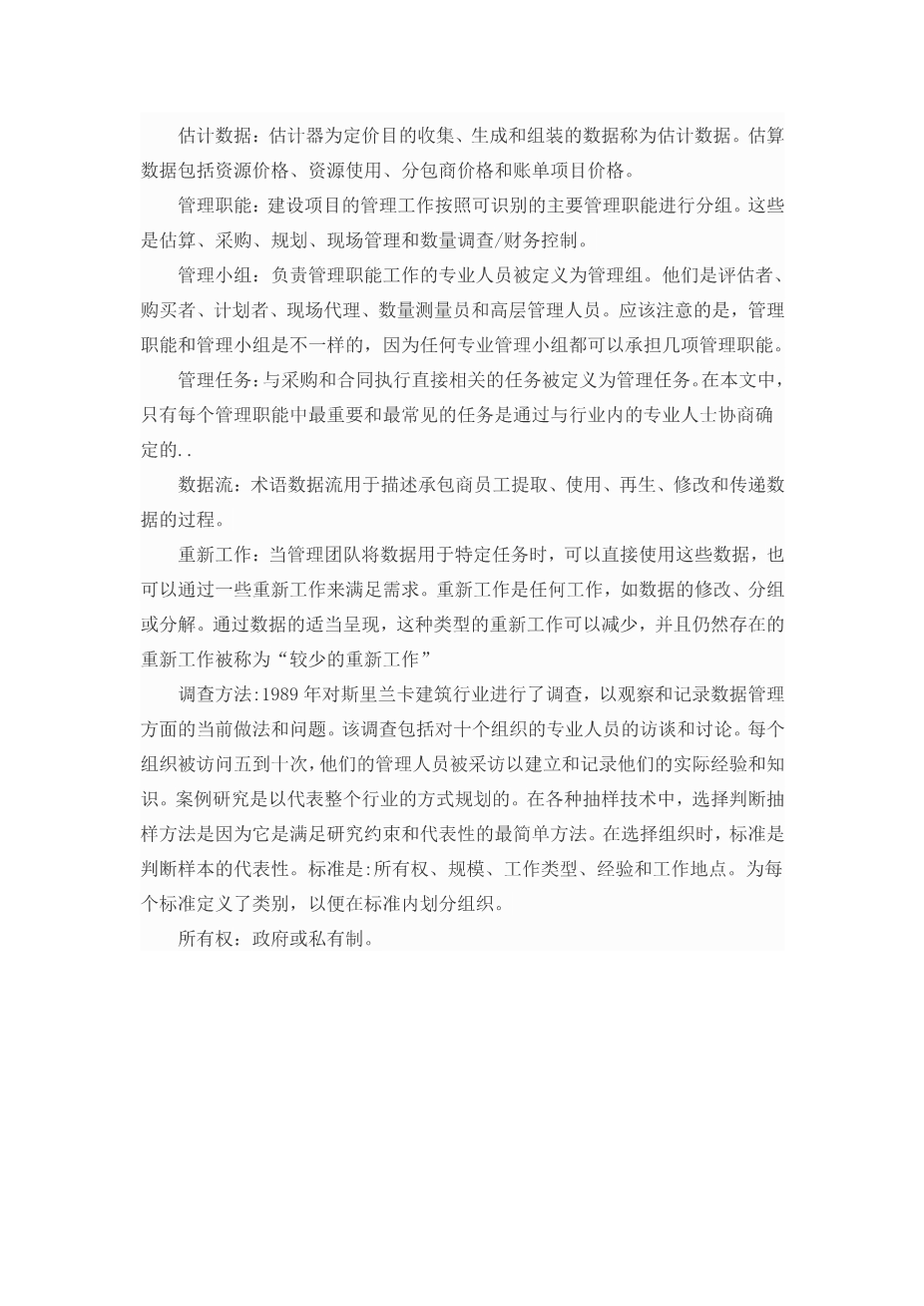Talking about Project Cost Management
When an estimator prices a bill of quantities, s/he collects, generates and assembles data (estimating data) for the purpose of establishing the cost of constructing the project. The data generated could be used by the contractor’s subsequent management functions, and the use of estimating data in the contractors’ post-tender management worthy of attention. Drawing information from ten case studies of the organization of Sri Lankan building contractors, this paper identifies the contractors’s management functions; management tasks; and management. It also establishes the flow of estimating data within and between the management functions. These flows highlight the substantial burden of re-work in the post-tender use of data. It is argued that the current format and presentation of estimating data in Sri Lanka are the major causes for such re-work. However, it was found that any revolutionary change to the conventional format would not be welcomed by the industry. Any new proposal should be developed within the limitation of acceptability to conventional practice. The recommendation is that the ‘unit rate’ is broken down to its cost components of material, labour and plant. The breakdown of the unit rate would supply all the necessary data for direct use, thus reducing the re-work. Further research should be addressed to investigate the best format and structure of this breakdown. Keywords: Bills of quantities, case studies, data management, estimating, Sri Lanka.
Introduction
Over the past four decades, many researchers have investigated the post-tender use of bills of quantities in contractors’ management. Alternative formats to the bill of quantities have emerged such as: Elemental Bill (Department of Education and Science, 1957), Sectionalised Trades Bill (Nott, 1963), Operational Bill (Forbes and Skoyles, 1963), Bill of Quantities一Operational Format一(Skoyles, 1968), BPF System一Schedule of Activities一(British Property Federation, 1983) and Builders’ Quantities (Pasquire and McCaffer, 1988). However, the conventional practice of preparing the bill of quantities, using the Standard Method of Measurement (Royal Institution of Chartered Surveyors, 1988), is still the widely used standard for preparation of bills of quantities (Kodikara, 1990). This does not mean that the current post-tender use of bills of quantities is efficient when used in the management of a contract by a contractor (Skinner, 1981). The BOQ is a client’s document for the client’s purposes. This paper reports on an investigation undertaken in 1989 into the contractors’ use of estimating data. The aim of the work was to observe the flow of estimating data in Sri Lankan building contractor organizations, and to identify reasons for inefficiency in contractors’ data management. To achieve this ten organizations were interviewed using a structured questionnaire. he questions were phrased as guide lines, so that they would lead to discussions revealing contractors’ current practices, problems and suggestions. Sri Lankan building construction industry follows some of the procedures, standards and principles that are used in the UK industry, hence the management of work in Sri Lankan building contractor organizations reflect some of the methods that are adopted in UK. Therefore, findings may also be of value to the UK industry. Parallel works on UK contractors’ data management have been researched by Pasquire and McCaffer (1987).
Definition of terms
In this paper, the following terms are used to describe the given meanings.
Estimating data
The data that are collected, generated and assembled by the estimator for pricing purposes are termed estimating data. Estimating data includes prices of resources, usages of resources, prices of sub-contractors and prices of bill items.
Management functions
The management work of a construction project is grouped according to recognizable major management functions. These are estimating, purchasing, planning, site management, and quantity surveying/financial control.
Management groups
The professionals who are responsible for the work of the management functions are defined as managementgroups. They are estimators, purchasers, planners, site agents, quantity surveyors and upper management. It should be noted that the management functions and management groups are not the same because any professional management group can undertake work in several management functions.
Management tasks
Tasks which are directly related to procurement and execution of contracts are defined as management tasks. In this paper, only the most important and common tasks in each management function are established through consultation with the professionals in the industry..
Data flow
The term data flow is used to describe the process of extracting, using, regenerating, amending and passing on of data by contractors’ staff.
Re-work
When data are used for a particular task by a management group they can be used either directly or with some re-work to suit the requirement. The re-work is any work such as modification, or grouping, or breaking up of data. By proper presentation of data, this type of re-work can be reduced and the re-work which still exists is called ‘less re-work’
Investigation methodology
The Sri Lankan building construction industry was surveyed in 1989 to observe and record the current practices and problems in data management. The survey comprised interviews and discussions with professionals to ten organizations. Each organization was visited between five and ten times, and their management staff were interviewed to establish and record their actual experience and knowledge. The case studies were planned in such a manner that they would represent the whole industry. Out of various sampling techniques , the judgement sampling method was select
剩余内容已隐藏,支付完成后下载完整资料


英语译文共 2 页,剩余内容已隐藏,支付完成后下载完整资料
资料编号:[443160],资料为PDF文档或Word文档,PDF文档可免费转换为Word
以上是毕业论文外文翻译,课题毕业论文、任务书、文献综述、开题报告、程序设计、图纸设计等资料可联系客服协助查找。


